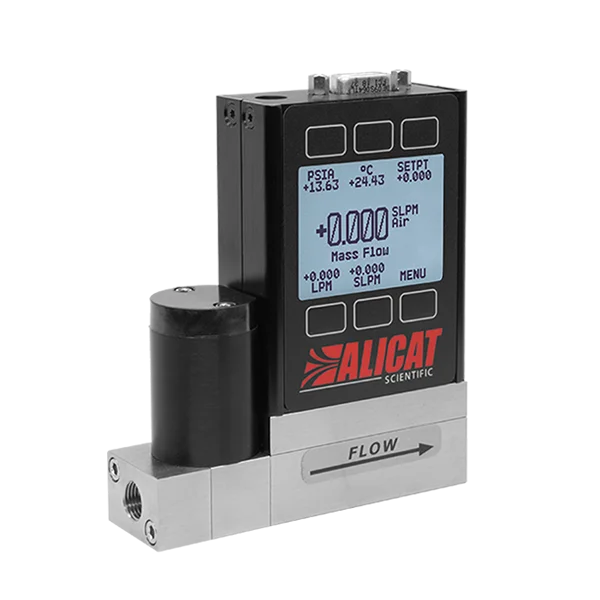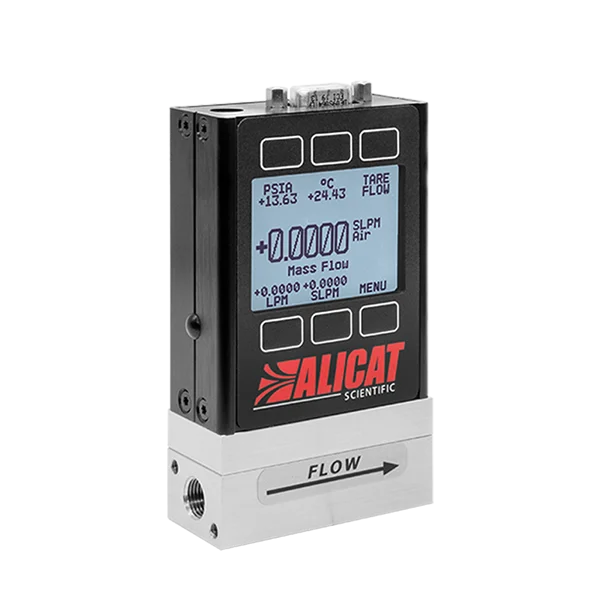Relative Humidity Sensing with Alicat Devices
Alicat® mass flow meters and controllers can be equipped with relative humidity (RH) sensors that enable precise monitoring of humidity within the gas stream.
This option ensures accurate control of process conditions by eliminating the need for manual corrections for moisture content. Humidity affects all materials, including the physical properties of gases. When water vapor enters a gas stream, it displaces part of the gas volume and alters viscosity and compressibility due to its different molecular weight and thermodynamic properties compared to dry gas. As a result, both mass flow and volumetric flow measurements become inaccurate unless moisture is accounted for, since water vapor occupies space and has a different mass than the gas itself.
What is relative humidity, and how do we measure it?
According to the NIST database, the amount of water vapor a gas mixture can hold — that is, its saturation point — depends strongly on temperature. For example, at 38 °C, a gas can hold about twice as much water vapor as it can at 25 °C; at 14 °C, it holds roughly half as much, and at 0 °C, only about one‑fifth as much.
As such, Alicat specifies 90% humidity as the maximum limit for its devices, as even a small change in temperature (around 1 °C) at higher temperatures can shift RH by more than 5%.
Alicat devices use RH sensors that measure using a capacitive sensing method. These sensors typically consist of a thin polymer layer sandwiched between a solid substrate and a porous protective layer. As this polymer absorbs or releases moisture from the surrounding air, its dielectric constant changes—since water has a high dielectric constant compared to air. This change in dielectric constant alters the capacitance of the sensor, which is measured using a precision oscillator circuit. The result is an extremely sensitive, accurate reading of relative humidity.
Alicat’s approach to humid gas measurement
In high‑humidity environments or applications where water vapor content can fluctuate, Alicat devices can normalize readings to reflect the flow as if no water vapor were present. This automatic correction removes the need for manual calculations, saving time and reducing the risk of error.
Upon factory calibration, the COMPOSER™ feature allows devices calculate the percentage of water vapor of the set gas and adjusts for viscosity and compressibility—delivering accurate dry gas flow measurements with response times faster than 10 ms.
Accurately relative humidity sensing also helps maintain proper stoichiometry in gas‑phase chemical reactions by ensuring that only the true reactant gases are counted toward reaction ratios. This prevents excess or insufficient dosing, reduces byproducts, and keeps reactions balanced and efficient, which is critical for maintaining precision in chemical dosing, gas mixing, and other sensitive processes.
In Alicat devices equipped with RH sensors, measurement uncertainty remains low under the following conditions: 25 °C, 1 atmosphere pressure, and 20 °C dew point.
- Overall uncertainty for Hydrogen (H2): ± 0.077% of reading
- Overall uncertainty for Oxygen (O2): ± 0.032% of reading
By contrast, a thermal capacitance flow meter would exhibit less accuracy under the same conditions (± 0.390% for H2 and ± 0.350% for O2).
In addition to its high measurement accuracy under humid conditions, Alicat Scientific’s integrated display allows users to monitor certain humidity conditions in real time:
- % of relative humidity
- Dew point
- % of water vapor
Alicat devices eliminate the need to do calculations yourself when tracking humidity‑related changes in gas behavior. Additionally, these readings are accessible through digital communication protocols like Serial or Ethernet.
For more information regarding common questions about how relative humidity sensors work with Alicat devices, including specifications, compatibility, and data handling, visit our Relative Humidity FAQ
Limitations
- The RH sensors are incompatible with certain volatile organic compounds (VOCS) as they are known to contaminate the sensor’s polymer layer by occupying the spaces meant for water molecules. Common sources of pollutants include plastics and packaging materials, potting compounds, glues, adhesives, and coatings. However, this is largely reversable with bakeout and time.
- The RH sensors are incompatible with corrosive gases. In applications where they are used with Alicat Scientific’s corrosion-resistant MS-series meters and MCS-series controllers, the primary purpose is to protect the sensor from moisture damage.
- As temperatures and humidity increase, the RH sensor will experience diminishing accuracy. At 90% RH, this will be approximately ±3% of reading, and above 50 °C, accuracy is around ± 5% of reading. Even so, gathering data on the gas humidity level when the temperature is suitable for an Alicat meter—before the gas enters a hot, wet environment—can be helpful in regulating how much humidity may be added or removed from the process downstream. Likewise, measurement of the RH in the gas after cooling of the output stream can serve as valuable feedback on the preceding process.
- Max pressure for the humidity sensors is 16 bar (approximately 15.8 atm or 232 psi)
Related Products
Humidity in industrial processes
In chemical, pharmaceutical, and high‑tech manufacturing, even small amounts of unexpected humidity can cause undesirable reactions or changes in process behavior. It’s also inevitable that small liquid droplets may exist within a system.
For instance, in hydrogen and oxygen electrolysis systems, users often choose thermal‑induction‑based flow meters because water vapor has less impact on those systems compared to differential pressure devices, which can be more sensitive to density changes from water vapor.
With Alicat RH‑enabled devices, users can correct for water vapor content on the fly—and with significantly better accuracy than a thermal meter. This capability is especially valuable in processes where dew point can fluctuate quickly, since even small temperature changes can dramatically affect RH readings.
To further support challenging humid environments, Alicat MS series devices offer anti‑corrosive options to protect against moisture damage.
Relative humidity in gases plays a critical role in process behavior—from flow dynamics and compression to chemical interactions. By accurately sensing and accounting for RH, Alicat Scientific ensures consistent performance, safety, and precision across a wide range of applications. Normalizing for the pure dry gas also helps maintain proper stoichiometry—critical in industrial chemical processes for minimizing contamination and unwanted byproducts from imbalanced reactions.


